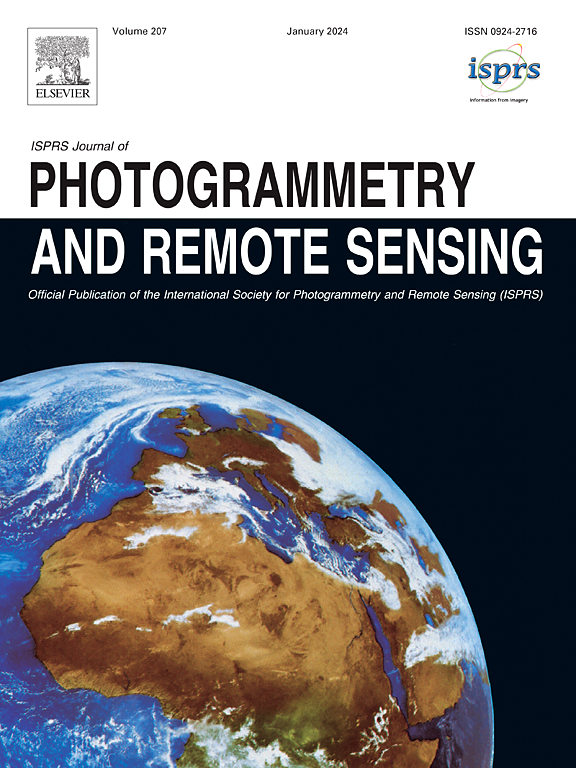Pointwise deep learning for leaf-wood segmentation of tropical tree point clouds from terrestrial laser scanning
IF 12.2
1区 地球科学
Q1 GEOGRAPHY, PHYSICAL
ISPRS Journal of Photogrammetry and Remote Sensing
Pub Date : 2025-06-25
DOI:10.1016/j.isprsjprs.2025.06.023
引用次数: 0
Abstract
Terrestrial laser scanning (TLS) is increasingly used in forest monitoring, providing detailed 3D measurements of vegetation structure. However, the semantic understanding of tropical tree point clouds, particularly the segmentation of leaf and wood components, remains a challenge. Deep learning (DL) on point clouds has been gaining traction as a valuable tool for automated leaf-wood segmentation, but its widespread adoption is impeded by data availability, a lack of open-source trained models, and knowledge on its influence on subsequent woody volume reconstruction. To address these issues, this paper makes three key contributions. First, it introduces a new dataset consisting of 148 tropical tree TLS point clouds from north-eastern Australia with manual leaf-wood annotations. Second, it uses this dataset to compare several state-of-the-art point-wise DL networks and benchmark these against traditional approaches, using a common training and inference pipeline to allow for a fair model comparison. We conduct an ablation study to examine the effects of various hyperparameters and modelling choices, focusing solely on point coordinates as input to develop a model adaptable to different forest types, platforms, and point cloud qualities. Third, we assess the impact of point-wise segmentation quality on tropical tree volume estimation using quantitative structure model (QSM) reconstruction on the extracted woody component. Results show that our newly trained DL models significantly outperform traditional benchmarks for leaf-wood segmentation of tropical tree point clouds from TLS, with PointTransformer achieving the highest performance (mIoU = 92.2 %). Quantitative and qualitative analyses reveal that DL methods excel in distinguishing woody points, crucial for woody volume estimation via QSMs, but may suffer from connectivity issues due to lack of physical constraints. Volumes of trees segmented using PointTransformer closely match those of manually segmented trees (MAE = 7.1 %), highlighting its suitability for automated woody volume estimation. Although this study demonstrates the effectiveness of state-of-the-art neural architectures for tropical tree point cloud processing, advocating for their integration into forest structure analysis pipelines, future work should focus on enhancing quantity, quality and variety of training data, to increase model robustness and generalisability. We make the dataset, code and trained DL models publicly available.1
基于点向深度学习的陆地激光扫描热带树木点云叶木分割
地面激光扫描(TLS)在森林监测中的应用越来越广泛,它提供了植被结构的详细三维测量。然而,热带树点云的语义理解,特别是树叶和木材成分的分割,仍然是一个挑战。点云上的深度学习(DL)作为一种有价值的自动树叶-木材分割工具已经获得了广泛的应用,但其广泛采用受到数据可用性、缺乏开源训练模型以及对后续木材体积重建影响的知识的阻碍。为了解决这些问题,本文做出了三个关键贡献。首先,引入了一个新的数据集,该数据集由来自澳大利亚东北部的148棵热带树木TLS点云组成,并带有手动树叶-木材注释。其次,它使用该数据集来比较几个最先进的逐点深度学习网络,并将它们与传统方法进行基准测试,使用通用的训练和推理管道来进行公平的模型比较。我们进行了一项消融研究,以检查各种超参数和建模选择的影响,仅关注点坐标作为输入,以开发适应不同森林类型、平台和点云质量的模型。第三,利用定量结构模型(QSM)对提取的木质成分进行重建,评估逐点分割质量对热带树木体积估算的影响。结果表明,我们新训练的深度学习模型明显优于传统的基于TLS的热带树木点云的树叶-木材分割基准,其中PointTransformer达到了最高的性能(mIoU = 92.2%)。定量和定性分析表明,深度学习方法在区分木材点方面表现出色,这对于通过qsm估计木材体积至关重要,但由于缺乏物理约束,可能会受到连接问题的影响。使用PointTransformer分割的树木体积与手动分割的树木非常匹配(MAE = 7.1%),突出了它对自动木材体积估计的适用性。虽然本研究证明了最先进的神经网络架构在热带树木点云处理中的有效性,提倡将其整合到森林结构分析管道中,但未来的工作应侧重于提高训练数据的数量、质量和种类,以提高模型的鲁棒性和通用性。我们让数据集、代码和训练好的深度学习模型公开可用
本文章由计算机程序翻译,如有差异,请以英文原文为准。
求助全文
约1分钟内获得全文
求助全文
来源期刊

ISPRS Journal of Photogrammetry and Remote Sensing
工程技术-成像科学与照相技术
CiteScore
21.00
自引率
6.30%
发文量
273
审稿时长
40 days
期刊介绍:
The ISPRS Journal of Photogrammetry and Remote Sensing (P&RS) serves as the official journal of the International Society for Photogrammetry and Remote Sensing (ISPRS). It acts as a platform for scientists and professionals worldwide who are involved in various disciplines that utilize photogrammetry, remote sensing, spatial information systems, computer vision, and related fields. The journal aims to facilitate communication and dissemination of advancements in these disciplines, while also acting as a comprehensive source of reference and archive.
P&RS endeavors to publish high-quality, peer-reviewed research papers that are preferably original and have not been published before. These papers can cover scientific/research, technological development, or application/practical aspects. Additionally, the journal welcomes papers that are based on presentations from ISPRS meetings, as long as they are considered significant contributions to the aforementioned fields.
In particular, P&RS encourages the submission of papers that are of broad scientific interest, showcase innovative applications (especially in emerging fields), have an interdisciplinary focus, discuss topics that have received limited attention in P&RS or related journals, or explore new directions in scientific or professional realms. It is preferred that theoretical papers include practical applications, while papers focusing on systems and applications should include a theoretical background.
 求助内容:
求助内容: 应助结果提醒方式:
应助结果提醒方式:


